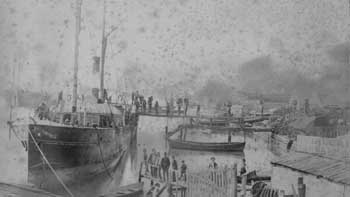
In mid-1875 a new ship started construction in London, England. The vessel
was the SS Duckenfield and the shipbuilder was J. & W. Dudgeon. The new ship
was 49.1 metres long and 7.3 metres wide with a displacement of 368 tons gross.
She was powered by a two cylinder vertical steam engine (also built by J. &
W. Dudgeon) turning a single prop.
Late that year, the Duckenfield left London for Newcastle where she was due to
join the fleet of J. & A. Brown. As well as delivering the ship, cargo was
being carried, namely 31 wagons and 40 sets of wheels for the Minmi colliery in
the Hunter Valley (interestingly, a ship called the SS Minmi was later to be
wrecked off the Southern Sydney coast).

A photo of the SS Duckenfield courtesy of Warwick Taylor whose grandfather, a
member of the Coal Lumpers Union, possibly took it.
After off-loading the cargo at Hexham, up the Hunter River, the Duckenfield was
towed to Sydney to have her propeller fitted. For an unknown reason, the
Duckenfield travelled to Newcastle under sail rather than steam. On 29 March
1876, the Duckenfield started work for J. & A. Brown. The vessels regular
trip was from Newcastle to Sydney but occasionally she transported coal from the
southern coalfields to Sydney.
For more than 13 years, the Duckenfield worked at her trade without problems. On
Friday 24 May 1889, the Duckenfield left Newcastle for Sydney. As well as her
usual cargo of coal and coke, the Duckenfield was carrying 50 tons of copper
ingots, in transit from South Australia to London. The skipper of the ship was
Captain Thomas Hunter. He had been in charge of the Duckenfield for six years,
doing more than 600 voyages.
As the Duckenfield passed Broken Bay, heavy rain began to fall and the land was
lost from sight. At 7.00pm, the ship approached Long Reef and a few minutes
later the Duckenfield was aground on the rock platform. Although the ship was on
the shore, the water was 60 feet deep under the bow and already two feet of
water was in the engine room.
The ship was abandoned and all crew safely left the vessel in the lifeboats.
Picked up by the Hawkesbury, the crew arrived at Watsons Bay in Sydney Harbour
at 10pm. The Marine Board of Inquiry found that "the Duckenfield was lost
by the wrongful act or default of Thomas Hunter, the Master, in navigating too
close to the coast and approaching Sydney from the northward without opening out
the South Head light". His certificate was suspended for six months. This
was not to be the last incident involving Captain Hunter. Just over a year
later, on 14 July 1890, the SS Royal Shepherd, also under the command of Captain
Hunter, sank as it left Sydney Harbour.
The cargo of copper was quite valuable so an attempt was made to salvage it. The
Duckenfield had slipped off Long Reef and a week after the accident, a search
showed two masts sticking out of the water in 80 feet north of Long Reef. On 11
June (18 days after the sinking) the masts could not be found but on 18 August
one mast was sighted. Two buoys were tied to the mast and a team of salvage
divers from the Sydney Marine Underwriters Association under the direction of
Captain John Hall began to salvage the copper from the wreck. The two divers
used, Arthur Briggs and William May, recovered 32 tons of copper from the wreck
over a weeks work. The same team salvaged 69 ships over a 13 year period, the
most famous being the recovery of gold from the wreck of the SS Catterthun off
Seal Rocks in 1895/6.
The Duckenfield was lost to knowledge from 1889 till it was rediscovered by Alan
and Neil McLennan almost 100 years later in 1987. On 24 May 1989, exactly 100
years after the sinking, the McLennans released details of the wreck to the
diving public in a gala event at the University of NSW. The GPS Reading for the
wreck is 33 43 11"S 151 19' 23"E. Not sure what datum was used.
The wreck today is extremely broken up (understandable considering Briggs and
May used explosives to remove the copper). The main features remaining are the
lower section of the hull together with the ribs. The twin cylinder engine sits
up a fair bit off the wreck and is the most prominent piece of the wreck. A
short distance away is the boiler and nearby the donkey boiler. The driveshaft
extend out of the engine and a single blade of the propeller lies just past its
end. Further on is the rudder. Strangely, the main section of the prop lies at
the opposite end of the wreck.
Further up the wreck is a winch and in this area the remaining copper ingots
lie. Past here there are two anchors from the salvage effort and nearby is the
bow section. Here there are the ships anchors as well as the chain and a davit.
The wreck is very interesting, and can easily be seen in one dive given its
23 metre maximum depth.
From © Michael McFadyen -
Devilfish Diving Services